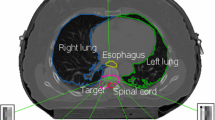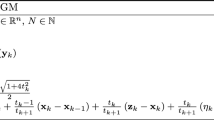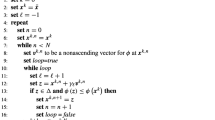Abstract
The projected subgradient method for constrained minimization repeatedly interlaces subgradient steps for the objective function with projections onto the feasible region, which is the intersection of closed and convex constraints sets, to regain feasibility. The latter poses a computational difficulty, and, therefore, the projected subgradient method is applicable only when the feasible region is “simple to project onto.” In contrast to this, in the superiorization methodology a feasibility-seeking algorithm leads the overall process, and objective function steps are interlaced into it. This makes a difference because the feasibility-seeking algorithm employs projections onto the individual constraints sets and not onto the entire feasible region.
We present the two approaches side-by-side and demonstrate their performance on a problem of computerized tomography image reconstruction, posed as a constrained minimization problem aiming at finding a constraint-compatible solution that has a reduced value of the total variation of the reconstructed image.


Similar content being viewed by others
References
Ruszczyński, A.: Nonlinear Optimization. Princeton University Press, Princeton (2006)
Nesterov, Y.: Introductory Lectures on Convex Optimization. Kluwer Academic, Doredrecht (2004)
Shor, N.Z.: Minimization Methods for Non-Differentiable Functions. Springer, Berlin (1985)
Poljak, B.T.: A general method of solving extremum problems. Sov. Math. Dokl. 8, 593–597 (1967)
Polyak, B.T.: Minimization of unsmooth functionals. USSR Comput. Math. Math. Phys. 9, 14–29 (1969)
Beck, A., Teboulle, M.: Mirror descent and nonlinear projected subgradient methods for convex optimization. Oper. Res. Lett. 31, 167–175 (2003)
Butnariu, D., Davidi, R., Herman, G.T., Kazantsev, I.G.: Stable convergence behavior under summable perturbations of a class of projection methods for convex feasibility and optimization problems. IEEE J. Sel. Top. Signal Process. 1, 540–547 (2007)
Censor, Y., Elfving, T., Herman, G.T.: Averaging strings of sequential iterations for convex feasibility problems. In: Butnariu, D., Censor, Y., Reich, S. (eds.) Inherently Parallel Algorithms in Feasibility and Optimization and Their Applications, pp. 101–114. Elsevier, Amsterdam (2001)
Censor, Y., Segal, A.: On the string averaging method for sparse common fixed point problems. Int. Trans. Oper. Res. 16, 481–494 (2009)
Censor, Y., Segal, A.: On string-averaging for sparse problems and on the split common fixed point problem. Contemp. Math. 513, 125–142 (2010)
Censor, Y., Tom, E.: Convergence of string-averaging projection schemes for inconsistent convex feasibility problems. Optim. Methods Softw. 18, 543–554 (2003)
Penfold, S.N., Schulte, R.W., Censor, Y., Bashkirov, V., McAllister, S., Schubert, K.E., Rosenfeld, A.B.: Block-iterative and string-averaging projection algorithms in proton computed tomography image reconstruction. In: Censor, Y., Jiang, M., Wang, G. (eds.) Biomedical Mathematics: Promising Directions in Imaging, Therapy Planning and Inverse Problems, pp. 347–367. Medical Physics, Madison (2010)
Censor, Y., Davidi, R., Herman, G.T.: Perturbation resilience and superiorization of iterative algorithms. Inverse Probl. 26, 065008 (2010)
Davidi, R., Herman, G.T., Censor, Y.: Perturbation-resilient block-iterative projection methods with application to image reconstruction from projections. Int. Trans. Oper. Res. 16, 505–524 (2009)
Herman, G.T., Davidi, R.: Image reconstruction from a small number of projections. Inverse Probl. 24, 045011 (2008)
Nikazad, T., Davidi, R., Herman, G.: Accelerated perturbation-resilient block-iterative projection methods with application to image reconstruction. Inverse Probl. 28, 035005 (2012)
Penfold, S.N., Schulte, R.W., Censor, Y., Rosenfeld, A.B.: Total variation superiorization schemes in proton computed tomography image reconstruction. Med. Phys. 37, 5887–5895 (2010)
Aharoni, R., Censor, Y.: Block-iterative projection methods for parallel computation of solutions to convex feasibility problems. Linear Algebra Appl. 120, 165–175 (1989)
Bauschke, H.H., Borwein, J.M.: On projection algorithms for solving convex feasibility problems. SIAM Rev. 38, 367–426 (1996)
Bauschke, H.H., Combettes, P.L.: Convex Analysis and Monotone Operator Theory in Hilbert Spaces. Springer, New York (2011)
Censor, Y., Chen, W., Combettes, P.L., Davidi, R., Herman, G.T.: On the effectiveness of projection methods for convex feasibility problems with linear inequality constraints. Comput. Optim. Appl. 51, 1065–1088 (2012)
Censor, Y., Zenios, S.A.: Parallel Optimization: Theory, Algorithms, and Applications. Oxford University Press, New York (1997)
Cegielski, A.: Iterative Methods for Fixed Point Problems in Hilbert Spaces. Lecture Notes in Mathematics, vol. 2057. Springer, Berlin (2012)
Herman, G.T., Garduño, E., Davidi, R., Censor, Y.: Superiorization: an optimization heuristic for medical physics. Med. Phys. 39, 5532–5546 (2012)
Jin, W., Censor, Y., Jiang, M.: A heuristic superiorization-like approach to bioluminescence tomography. In: International Federation for Medical and Biological Engineering (IFMBE) Proceedings, vol. 39, pp. 1026–1029 (2012)
Luo, S., Zhou, T.: Superiorization of EM algorithm and its application in single-photon emission computed tomography (SPECT). Inverse Problems and Imaging. Accepted for publication
Bauschke, H.H., Koch, V.R.: Projection methods: swiss army knives for solving feasibility and best approximation problems with halfspaces. In: Reich, S., Zaslavski, A. (eds.) Proceedings of the Workshop “Infinite Products of Operators and Their Applications”, Haifa, 2012 (2013). Accepted for publication https://people.ok.ubc.ca/bauschke/Research/c16.pdf
Helou Neto, E.S., De Pierro, Á.R.: Incremental subgradients for constrained convex optimization: a unified framework and new methods. SIAM J. Optim. 20, 1547–1572 (2009)
Helou Neto, E.S., De Pierro, Á.R.: On perturbed steepest descent methods with inexact line search for bilevel convex optimization. Optimization 60, 991–1008 (2011)
Nedić, A.: Random algorithms for convex minimization problems. Math. Program., Ser. B 129, 225–253 (2011)
Ram, S.S., Nedić, A., Veeravalli, V.: Incremental stochastic subgradient algorithms for convex optimization. SIAM J. Optim. 20, 691–717 (2009)
Nurminski, E.A.: The use of additional diminishing disturbances in Fejer models of iterative algorithms. Comput. Math. Math. Phys. 48, 2154–2161 (2008). Original Russian text: Nurminski, E.A.: Ž. Vyčisl. Mat. Mat. Fiz. 48, 2121–2128 (2008)
Nurminski, E.A.: Fejer processes with diminishing disturbances. Dokl. Math. 78, 755–758 (2008). Original Russian text: Nurminski, E.A.: Dokl. Akad. Nauk SSSR 422, 601–604 (2008)
Nurminski, E.A.: Envelope stepsize control for iterative algorithms based on Fejer processes with attractants. Optim. Methods Softw. 25, 97–108 (2010)
Nurminski, E.A.: Fejer algorithms with an adaptive step. Comput. Math. Math. Phys. 51, 741–750 (2011). Original Russian text: Nurminski, E.A.: Ž. Vyčisl. Mat. Mat. Fiz. 51, 791–801 (2011)
Sidky, E.Y., Kao, C., Pan, X.: Image reconstruction in circular cone-beam computed tomography by constrained, total-variation minimization. Phys. Med. Biol. 53, 4777–4807 (2008)
Herman, G.T.: Fundamentals of Computerized Tomography: Image Reconstruction from Projections, 2nd edn. Springer, Berlin (2009)
Combettes, P.L., Pesquet, J.C.: Image restoration subject to a total variation constraint. IEEE Trans. Image Process. 13, 1213–1222 (2004)
Nesterov, Y.E.: A method for solving the convex programming problem with convergence rate O(1/k 2). Sov. Math. Dokl. 27, 372–376 (1983)
Güler, O.: Complexity of smooth convex programming and its applications. In: Pardalos, P.M. (ed.) Complexity of Numerical Optimization, pp. 180–202. World Scientific, Singapore (1993)
Davidi, R., Herman, G.T., Klukowska, J.: SNARK09: A programming system for the reconstruction of 2D images from 1D projections (2009). http://www.dig.cs.gc.cuny.edu/software/snark09/
Klukowska, J., Davidi, R., Herman, G.T.: SNARK09—A software package for reconstruction of 2D images from 1D projections. Comput. Methods Programs Biomed. 110, 424–440 (2013)
Acknowledgements
We thank the editor and reviewer for their constructive comments. We would like to acknowledge the generous support by Dr. Ernesto Gomez and Dr. Keith Schubert in allowing us to use the GPU cluster at the Department of Computer Science and Engineering at California State University San Bernardino. We are also grateful to Joanna Klukowska for her advice on using optimized compilation for speeding up SNARK09. This work was supported by the United States–Israel Binational Science Foundation (BSF) Grant No. 200912, the U.S. Department of Defense Prostate Cancer Research Program Award No. W81XWH-12-1-0122, the National Science Foundation Award No. DMS-1114901, the U.S. Department of Army Award No. W81XWH-10-1-0170, and by Grant No. R01EB013118 from the National Institute of Biomedical Imaging and Bioengineering and the National Science Foundation. The contents of this publication is solely the responsibility of the authors and does not necessarily represent the official views of the National Institute of Biomedical Imaging and Bioengineering or the National Institutes of Health.
Author information
Authors and Affiliations
Corresponding author
Additional information
Communicated by Masao Fukushima.
Rights and permissions
About this article
Cite this article
Censor, Y., Davidi, R., Herman, G.T. et al. Projected Subgradient Minimization Versus Superiorization. J Optim Theory Appl 160, 730–747 (2014). https://doi.org/10.1007/s10957-013-0408-3
Received:
Accepted:
Published:
Issue Date:
DOI: https://doi.org/10.1007/s10957-013-0408-3




